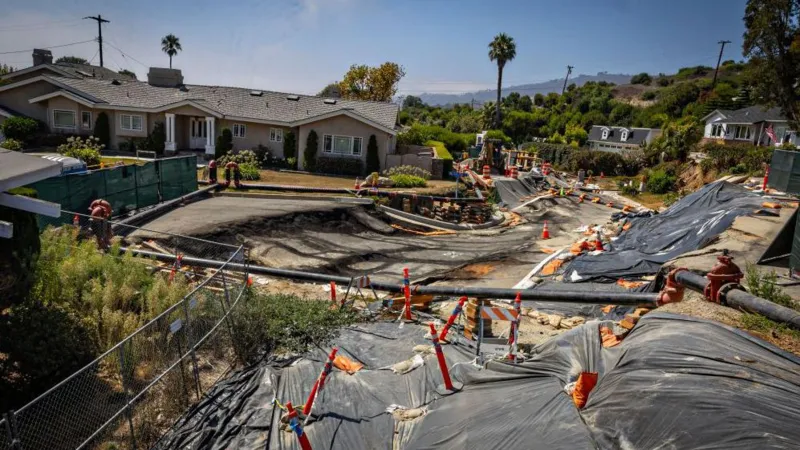In a dramatic response to increasing landslides, officials have cut power to several homes in Los Angeles County’s prestigious Rancho Palos Verdes neighborhood. The measure, aimed at preventing potential disasters, reflects the severity of the ongoing geological upheaval affecting this high-class area.
Located about 25 miles south of downtown Los Angeles, Rancho Palos Verdes is renowned for its spectacular coastal views and luxurious residences. However, the charm of this community is being tarnished by the frequent landslides that have been destabilizing the area for years. Recently, the situation has worsened, forcing Southern California Edison to cut power to 140 homes in the Portuguese Bend area, with power outages expected to increase.
Landslides, characterized by rapid movement of land, have become a significant concern for both residents and officials. According to City Council member David Bradley, some parts of the terrain are sliding up to 10 inches per week, which is a worrisome and unprecedented pace. Bradley emphasized the severity of the situation, saying, “You can almost see the ground moving.”
The decision to cut off power was driven by the need to reduce the risk of fires and other hazards associated with unstable land. Last week, a downed power line ignited a small wildfire in Portuguese Bend, underscoring the dangers of maintaining power in such an unstable environment. Southern California Edison spokesman Larry Chung explained that the disconnection was a preventive measure to avoid potential fire outbreaks caused by ground movement affecting power infrastructure.
In addition to power outages, gas and water services have also been suspended in the affected area. Landslides, which have been increasing gradually over the past few years, have intensified in recent months, partly due to the heavy rains that have been falling in California. This sudden increase in movement has caught many by surprise and has sparked calls for more extensive state and federal intervention.
Los Angeles County Supervisor Janice Hahn has been vocal about the need to increase aid, saying that the $5 million allocated for disaster relief is insufficient. She has urged California Governor Gavin Newsom to visit the area and consider declaring a state of emergency. Despite these calls, evacuations have not been made mandatory, although officials have advised residents to voluntarily leave the area.
Law enforcement has also stepped in, with Los Angeles County Sheriff Robert Luna announcing that drones will be deployed to monitor the changing landscape. This high-tech approach is intended to provide real-time data on the progress of the landslide and enhance safety measures.
The situation has generated varying reactions from residents. Some, like Jim Denver, have expressed frustration over the power cuts, feeling abandoned by the utility company. Denver told ABC News that he was “left alone in the middle of the ocean to swim back home” and criticized the decision to cut power. Another resident, Tom Keefer, echoed similar sentiments, saying, “We’re not going to give up despite the warnings.” Landslides are not a new phenomenon in Portuguese Bend. It is part of a larger, ancient landslide complex that has been active for decades. The area’s susceptibility to land slides was further increased by the expansion of Crenshaw Boulevard in 1956, which reactivated the landslides. Since then, the neighborhood has struggled with the effects of this geological instability, which has slid homes hundreds of feet and caused significant damage to infrastructure.
The City of Rancho Palos Verdes spends approximately $1 million annually on road repairs due to the frequent eroding and cracking of roads caused by landslides. This ongoing maintenance highlights the persistent challenges the community faces in managing the effects of unstable land.
As the situation unfolds, residents and officials are grappling with the complexities of living in a geologically unstable area. The power outages, while a necessary measure for safety, highlight the tension between maintaining modern conveniences and addressing the risks posed by the natural environment. The community is divided, with some residents choosing to stay put despite the dangers, while others heed the warnings and evacuate.
The ongoing landslide crisis in Rancho Palos Verdes is a stark reminder of the impact of natural hazards on human settlements. As experts continue to monitor the situation and officials seek additional assistance, the future of this specific neighborhood remains uncertain. The response to the crisis, including power outages, emergency funding, and technical monitoring, reflects the broader challenges of managing and mitigating the impacts of natural disasters in vulnerable areas.
